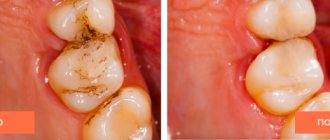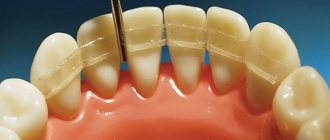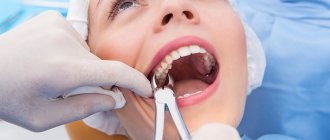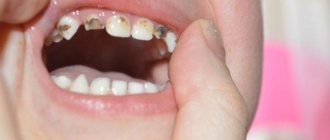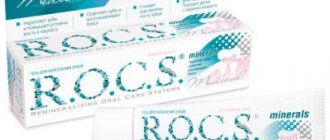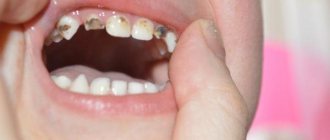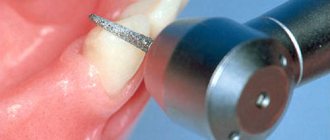People turn to the dentist when they have any problems with the health of their teeth or gums. Pain in the tooth, swelling of the gums, increased sensitivity of the teeth, bad breath - all these phenomena can appear against the background of various dental diseases and, based on the nature of the disease, the specialist selects the optimal method of dental treatment.
Whatever method of dental treatment is chosen, its main task will be to preserve all the functions and aesthetics of the tooth. Below we will look at a variety of dental treatment methods that are used in modern dentistry and will also talk about complications that can occur when errors in treatment procedures were made by the doctor.
Methods and timing of modern treatment of dental diseases
Dental treatment in modern dental clinics is a whole series of special measures to stop the development of the inflammatory process, restore all useful functions, as well as the aesthetics of the dental unit. Most often, patients turn to dentists for the treatment of dental caries, which occurs in people of all ages and in a variety of forms - from the spot stage to deep caries, when the destruction of a unit has reached almost to the root. If caries was not cured on time or its treatment was carried out in violation of the rules, complications such as pulpitis and periodontitis arise. Treatment of these dental diseases is more complex; it is carried out in stages and involves at least 2-3 visits to a specialist’s office. The timing of dental treatment always depends on the complexity of the clinical case. For example, treatment of caries in the spot stage takes place in one visit
dentist, implantation and prosthetics are divided into several stages and the treatment period is maximum - from several months to a year. Do you want dental treatment to always proceed quickly and with a minimum of discomfort? Then attend regular preventive examinations at the dentist, because it has long been known that the best dental treatment is prevention!
Folk help for tooth root abscess
It is possible to determine that the pain syndrome is caused by a tooth root abscess by the presence of swelling on the side of the diseased tooth. A lump (flux) is usually felt in the root zone. The pain is constant, pulsating and bursting, and body temperature may rise.
Folk remedies against toothache caused by gumboil are aimed not only at pain relief, but also at slowing down the inflammatory process. However, with a developing root abscess, only a doctor using special equipment can determine the extent and stage of the inflammatory process and prescribe adequate treatment.
Compress
An anti-flux compress helps relieve pain and reduce swelling. To prepare it, a teaspoon of sugar is mixed with a teaspoon of extra salt and half a teaspoon of ground black pepper. Then three percent table vinegar in the amount of one teaspoon is added to the mixture - you should get a thick paste.
When all ingredients are added, the mixture is heated in the microwave or over heat until thickened. After the mass has cooled, it is applied to the sore spot.
Gargling with sage decoction
To prepare the rinse solution, you need to combine half a liter of boiling water with 2 tablespoons of dried sage and leave the mixture covered until it cools completely. After the liquid has cooled, the broth should be strained and divided into 2 servings. You need to use it twice a day. After the first rinse, the intensity of the pain will decrease, after the second, there will be a slight decrease in swelling.
Blue clay
Blue clay helps fight swelling more than it serves as a pain reliever. During initial use, the pain may intensify and not stop within the first 5-10 minutes after application.
A small piece of clay wrapped in sterile gauze is used. Clay is applied not to the tooth itself, which hurts, but to the gum. A reduction in swelling is visible after the first use. And the pain goes away gradually: as the inflammatory process decreases.
Onion juice
A cotton swab dipped in raw onion juice is placed on the sore tooth. You can squeeze juice from an onion in two ways: using a juicer or chopping the onion in a blender and squeezing out the juice using gauze. You need to keep the onion lotion on the tooth until the pain stops completely.
Endodontic dental treatment: when and how is it carried out?
Endodontic dental treatment is used in practice if caries has destroyed the tooth and the inflammatory process has moved into the canals of the dental unit. When carrying out endodontic dental treatment, a specialist treats the canals: cleans the cavities from damaged tissue, rinses them with an antiseptic solution, and applies medicine. Typically, after these procedures, a temporary filling is placed on the tooth, and the patient is sent home to return to the dentist's office in a few days.
At the second visit, an x-ray of the diseased tooth is taken to evaluate the effectiveness of the treatment. If the inflammation has been stopped, the canals are treated with an antiseptic again, and then their space is filled with gutta-percha. The tooth treatment ends with the final restoration of the crown using a composite filling material.
Endodontic treatment must be carried out with high quality and using specialized modern tools: files that allow the canals to be expanded as needed, a microscope that allows the doctor to see the condition of the tissues and canals, an apex locator that shows the length of the tooth canals.
If root canal treatment is carried out incorrectly, errors are made in its technology - there are risks of serious complications that can lead to the loss of a dental unit.
Universal folk recipes against toothache
Regardless of the cause of pain, the main task when eliminating it at home is not to provoke inflammation and not to harm the diseased tooth. Therefore, it is permissible to use only gentle natural analgesics. The fastest and most effective folk remedies for toothache are:
- Rinse with saline solution with iodine. A teaspoon of sea or table salt and 7 drops of iodine are dissolved in a glass of warm boiled water. The solution can be used immediately after the crystals of the substance have completely dissolved. The intensity of pain decreases after 3–5 minutes. It is permissible to rinse your mouth no more than three times a day.
- Rinse with green tea and garlic. A tablespoon of green tea is brewed in 250 ml of boiling water. The drink is infused for 15 minutes, after which you need to add 5 cloves of garlic, grated on a fine grater. The mixture should be left for another ten minutes and then strained. Immediately before use, the tea should be warmed to a comfortable room temperature.
Gargling is not the only way to get rid of toothache at home using garlic. You can simply grate a vegetable clove and apply the resulting pulp to the inflamed gum; the essential oils it contains will help eliminate pain and have an antiseptic effect.
- Lotion with valerian. A cotton pad is cut into 4 parts, one piece is soaked in an alcoholic infusion of valerian and placed on the sore tooth. As necessary, the tampon is replaced with a new one.
- Compress with salt, onion and garlic. To prepare an anesthetic paste, you need to finely grate the onion and garlic cloves and mix the resulting paste with salt. Take a teaspoon of all ingredients. The paste is applied to the diseased tooth and covered with a cotton swab. The compress eliminates pain within a few minutes. This method of pain relief can be used an unlimited number of times a day.
Mouth rinse with herbal infusions
Warm decoctions for rinsing are effective for toothache of any nature. The simplest folk remedy that helps quickly eliminate toothache is rinsing with soda and salt: half a teaspoon of soda and three drops of iodine are diluted in a glass of warm boiled water. The solution numbs the tooth and disinfects the oral cavity.
To prepare 250 ml of herbal decoction, use 1 tablespoon of dried medicinal plants. The raw material is poured with a glass of boiling water and boiled in a water bath for 10 minutes, after which it is filtered. You can use the product after it has cooled.
The most effective are decoctions based on:
- sage;
- mint;
- oak bark;
- echinacea;
- chamomile flowers;
- eucalyptus.
The beneficial analgesic effect of herbal rinses is recognized even by dentists, but when using them you must adhere to precautions:
- The decoction for rinsing inflamed gums and sore teeth should be warm; too hot or cold liquid can provoke increased inflammation.
- Medicinal herbs can cause severe allergic reactions in the form of rashes and swelling of the oral cavity, which can spread to the larynx, bronchi and even lungs. Therefore, for the initial use of each herbal collection, no more than 50 g of decoction should be used.
Lotions with essential oils
Essential oils have an anesthetic effect on the nerve, causing it to become temporarily numb. The most effective painkillers are oils:
- lemon balm;
- carnations;
- lemon;
- geraniums;
- basilica;
- cajuput tree;
- eucalyptus;
- fir trees
Method of use: two or three drops of essential oil are applied to a cotton swab, which is applied to the aching tooth for 5–7 minutes.
Essential oils are very concentrated, so it is forbidden to drip more than four drops and exceed the time of keeping the compress: there is a high risk of burning the mucous membrane and causing a sharp headache. The procedure can be repeated no more often than every 2 hours.
Is it possible to treat teeth without a drill?
Sociological surveys show: almost 80% of people are afraid to visit the dentist due to fear of having their teeth drilled. Not only children, but also adults are afraid of drills. If you are also afraid of the need to drill a tooth for its quality treatment, then it will be useful for you to know the following fact: if you seek dental care in a timely manner during dental treatment, you can completely do without a drill!
Fluoridation
If the examination reveals caries in the stain stage, then dental treatment may involve procedures aimed at remineralizing and strengthening the enamel. Tooth surfaces are covered with special gels containing high concentrations of fluoride and calcium and, of course, this treatment is absolutely painless!
Laser treatment
Another option for dental treatment without drilling is the use of laser radiation with a wavelength of a certain length. The laser beam heats and destroys tissues destroyed by caries, and after treatment it will be enough to rinse the area of manipulation with water. The innovative method of dental treatment has many advantages, including: high efficiency of the method; low risks of complications; additional antibacterial effect. The disadvantages include the fairly high price of laser dental treatment and a wide range of contraindications. It is also worth knowing that dental treatment with laser radiation will be painless only when caries has destroyed only the tooth enamel. If the destruction has reached the deep layers of dentin and pulp, before laser dental treatment, the patient is given anesthesia to eliminate unpleasant painful sensations.
Infiltration treatment method
Dental treatment is carried out using Icon technology, which consists of treating carious cavities with a special polymer composition. The active substances in the composition uncouple and dissolve damaged tissue, the remains of which the doctor removes with an alcohol solution. Then the treated areas of the tooth are dried and treated with a polymer resin that fills micropores in the natural enamel coating of the tooth. The tooth treatment using Icon technology ends with the use of a polymerization lamp, which dries the applied composition. The advantages of this dental technique include: maintaining the integrity of the natural enamel coating for a long time, increasing the strength of tooth enamel; the ability to choose a polymer shade that exactly matches the tone of natural enamel; speed of dental treatment - the entire treatment process takes no more than half an hour; The treatment is painless and does not involve the risk of overheating of the tooth tissue.
Icon dental treatment technology is optimal for treating carious stains in the interdental spaces and is suitable for eliminating caries in children.
Ozone therapy
Another method of treating teeth without drilling is ozone therapy, which involves exposing carious cavities to ozone. The impact is carried out by a special device that converts oxygen into ozone. This gas destroys pathogenic microflora and carious bacteria. After treatment with ozone, the tooth is covered with a special gel and the treatment process ends.
Ozone therapy can be used not only to treat teeth damaged by caries. It is indicated for inflammation of the soft tissues of the oral cavity, inflammatory processes in the dental canals.
Features of the dental treatment process under a crown
Installing a crown does not guarantee 100% protection of the tooth from caries and other dental diseases. Some time after the installation of a prosthetic structure in the patient’s oral cavity, phenomena such as subsidence of the gums and exposure of the cervical part of the tooth may be observed. These phenomena create favorable conditions for the development of caries and the risks of developing carious lesions are especially high due to insufficient oral hygiene. Under the crown, not only caries can develop, but also pulpitis and periodontitis, and therefore if you have pain in a tooth on which a crown has been placed, you need to seek professional treatment urgently!
If the diagnosis reveals caries or an inflammatory process under the crown, tooth treatment will involve removing the orthopedic structure and carrying out all the necessary manipulations to stop the inflammation and save the tooth.
Note that caries under the crown often appears because errors were made during the manufacture of the prosthetic structure or during its installation. If the crown is adjacent to natural tissues with insufficient density, pathogenic microflora can easily penetrate under it. For this reason, it is important to choose a good dental clinic for prosthetics, which employs experienced and competent specialists.
The need for anesthesia before dental treatment
Anesthesia during dental treatment is not always necessary, but only in cases where the destruction has affected the deep layers of dentin. There are nerve endings in the deep layers of tooth tissue, and therefore any manipulation in this area can cause significant pain to the patient. To eliminate discomfort during dental treatment under such circumstances, anesthesia is administered before the start of the treatment process, selected individually. The anesthetic is administered by injection, but there is no need to be afraid of an injection: modern syringes have ultra-thin needles that allow you to administer the medicine quickly and painlessly.
For patients with a high pain threshold, anesthesia can be given not only before dental treatment, but also before such activities as professional cleaning of dental surfaces and whitening. Typically, topical anesthesia is chosen. General anesthesia is used in dental treatment
extremely rarely - mainly before complex and lengthy operations. It is worth knowing that general anesthesia has a number of contraindications and therefore, before choosing this anesthesia technique, the patient must undergo a series of tests.
Specifics of dental treatment in the smile area
The front teeth are included in the so-called smile zone and therefore, when treating them, the aesthetics of the final result of the treatment process is fundamental. To restore an anterior tooth, the dentist must have experience in selecting shades of light-curing composites, recreating the natural shape of the tooth, and all the natural irregularities of its surface.
If the tooth located in the smile area is healthy, but there are aesthetic defects, the use of veneers may be a treatment option. Veneers are miniature plates-onlays that are glued to the surface of the teeth and ideally mask defects such as curvature of teeth, unsightly shape, darkening of the enamel, and interdental spaces. If a tooth is destroyed by more than fifty percent, restoration with a crown is indicated. A pin that is used by some specialists for severe tooth destruction
Installation is not recommended. A large filling will not withstand the load that is inevitable during chewing processes and will fall out or break off, along with part of the tooth. If the root part is affected when the filling is broken, the tooth will have to be removed. In the area of the front teeth, prosthetics made from durable and aesthetic materials are recommended: ceramics, porcelain, zirconium.
What to do if only cold water helps with pain
At a certain stage of the disease (in particular, with gangrenous pulpitis), rinsing with cold water can help. Please note, under no circumstances is it icy. Rather, we are talking about water at room temperature, which is perceived by our body as cold.
It will not be possible to completely remove toothache, but it is quite possible to alleviate your condition a little. When cooled, tissue swelling decreases slightly and the feeling of fullness goes away. When heated, the pain occurs again, some feel it with a vengeance. Regular rinsing every 5-10 minutes will help you get to the doctor, but will not remove the cause.
It is not recommended to use ice water for such purposes, since with a large temperature difference, cracking of the enamel is possible. This effect is especially unfavorable in cases of hypersensitivity. You can try to apply any cold object to the cheek on the sore side, but, again, not for long, to avoid possible inflammation of the trigeminal nerve (and this is another and also not a very funny story).
Important! Do not heat your cheek on the sore side and do not rinse your mouth with hot water. It's not guaranteed to help, and it's sure to make things worse.
Symptoms that may indicate the need for dental treatment
If you are worried about tooth pain, even if it is mild and appears from time to time, this is a clear reason to see a doctor and undergo professional dental treatment. The sooner you contact a specialist, the less likely it is that the treatment will be complex, protracted and painful. The following symptoms may also indicate the need for urgent dental treatment: The appearance of dental hypersensitivity; sharp, unpleasant odor from the mouth (if hygienic procedures for caring for the oral cavity are carried out on an ongoing basis); bleeding, swelling of gum tissue; problems with opening/closing the mouth; the appearance of spots, irregularities on the dental surfaces, and changes in the shade of tooth enamel. Remember that a timely visit to the dentist for tooth treatment is the only way to save the tooth. And your teeth are better than any, the most modern dentures!
Sedatives
Intravenous sedation is more convenient and safe. Throughout the procedure, the patient's pulse and blood pressure are monitored by an anesthesiologist-resuscitator. It also controls the depth of sedation: at the right time it prolongs its effect. The drug has sedative, muscle relaxant, anticonvulsant pharmacological properties. Its advantage is that it has an antidote that stops or weakens the effect of the drug on the body. After its administration, the patient immediately wakes up and feels great. Perhaps a little sleepy for an hour, but nothing more.
How is dental treatment performed in dentistry: an overview of the main stages
Unfortunately, most patients ignore dentists' advice on the importance of regular visits to the doctor and preventive examinations and therefore see a specialist with advanced caries, acute pain, and the presence of many different oral diseases. Therefore, dental treatment will always begin with diagnosis, and will also include the following stages:
Examination and treatment plan
An appointment with a doctor begins with an examination of the oral cavity, as well as prescribing a number of diagnostic tests for the patient. This will allow you to identify all existing dental and oral health problems and create a detailed treatment plan.
Professional sanitation of the oral cavity
It is recommended to begin dental treatment only after high-quality sanitation of the oral cavity, during which all types of plaque are removed from the dental surfaces.
Treatment
If a patient consults a doctor with medium or deep caries, dental treatment cannot be done without drilling. Using a drill, a specialist will remove all tissue damaged by the disease and create a cavity for installing a filling. Pulpitis and periodontitis imply a more complex treatment regimen, which includes canal treatment, antibiotic therapy, and some types of surgical interventions. The treatment method is selected based on the characteristics of the clinical case. The treatment of the tooth ends with the final restoration of its crown using photopolymer filling materials.
Causes of dental problems
The occurrence of a problem such as caries is associated with the destructive effect of bacteria on the structure of the teeth. The microflora in the oral cavity includes a huge number of microorganisms. Even proper and thorough brushing of teeth with special means and the use of rinses cannot make the oral cavity completely sterile. The proliferation of pathogenic bacteria begins 2-4 hours after the last cleaning.
What exact reasons can cause tooth damage?
- poor oral care;
- unbalanced diet;
- decline in immunity;
- gastrointestinal diseases;
- avitaminosis;
- insufficient amount of minerals (calcium, fluorine) in drinking water.
Are complications possible after dental treatment, what could they be?
For some time after dental treatment, the patient may be bothered by a slight aching pain, which usually occurs during the process of chewing food. In this case, there is no need to sound the alarm, such pain is not a complication: it is observed after treatment of deep caries due to the pressure of the filling on the pulp and will go away in a few days without taking any medications, on its own.
But if the tooth hurts severely and the discomfort does not disappear after taking painkillers, you should go to the doctor urgently! This symptom indicates the preservation and continuation of the active development of the inflammatory process in the tooth. Usually the cause of such a complication is poor quality of primary dental treatment. At Uni Dent dentistry in St. Petersburg you can undergo dental treatment of any complexity.
Our clinic offers patients modern dental treatment methods, innovative equipment, sensitive and experienced staff, and doctors who regularly improve their qualifications abroad. Trust the health of your teeth to professionals - come to Uni Dent dentistry in St. Petersburg!
